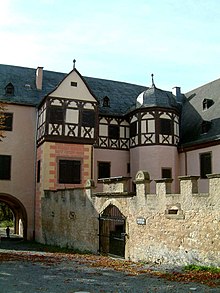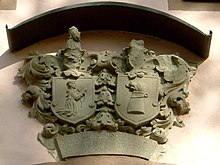Wilhelm Friedrich von Gleichen-Rußwurm
Wilhelm Friedrich Freiherr von Gleichen called von Rußwurm (born January 14, 1717 in Bayreuth ; † June 16, 1783 at Greifenstein Castle , Bonnland ) was a margrave of Bavaria's officer, freemason and natural scientist .
Life
origin

Friedrich Wilhelm Freiherr von Gleichen was a son of Heinrich von Gleichen (1681-1767) from the Thuringian Counts peers and his wife Carolina Dorothea Sophie von Russwurm (1693-1748) from the Frankish 1,732 extinct in the male line Uradelsgeschlecht of Rußwurm . The later colonel Christian Ernst Freiherr von Gleichen, called von Rußwurm (1719–1768), was his younger brother. The castle captain of Saalfeld and chief tax collector of the principality of Altenburg Hans Christoph von Gleichen (1656–1713) and the margravial Brandenburg-Kulmbach chief hunter Ernst Friedrich Freiherr von Rußwurm (1657–1732) were his grandfathers. The diplomat Karl Heinrich von Gleichen was his cousin.
Since Ernst Friedrich Freiherr von Rußworm had no offspring, he adopted his two grandchildren Wilhelm Friedrich and Christian Ernst. On February 25, 1732, the imperial approval was given by Emperor Charles VI. which allowed the descendants to bear the name of sootworm . Wilhelm Friedrich Freiherr von Gleichen took on the name after the death of his mother in Erlangen in 1748 and from that point on called himself Wilhelm Friedrich Freiherr von Gleichen called von Rußwurm. The family of the barons von Gleichen called von Rußwurm still exists today.
The godfather of Friedrich Wilhelm was the margrave of the Franconian principality of Bayreuth Georg Wilhelm von Brandenburg-Bayreuth .
Military career
Friedrich Wilhelm was given out of the house early because of his parents' constant marital disputes and grew up with relatives and friends of the family. In 1728 he came to the court of Prince von Thurn und Taxis in Frankfurt as a page, but already two years later he went to Dresden as a cadet, where he was taught his first rudimentary academic and academic basics. Because of a fatal duel, in which he was involved as a second, he had to flee the city in female clothing and then fled back to Bayreuth on foot, since the seconds awaited the same punishment as the duel participants after the Saxon duel mandate. In 1734 he joined the margravial Bavarian troops. He received the flag from the Dragoon Company with which he took part in the first campaign on the Rhine in 1734 as part of the War of the Polish Succession and in 1735 as a cuirassier lieutenant in the second campaign on the Rhine. During his first campaign, he was the orderly of Prince Eugene on several occasions . During the second campaign he served under General Petrasch in the command against the French captain Kleinholz, who captured 700 men in the battle near Philippsburg and left many dead on the battlefield. In contrast to many others of his class, Friedrich Wilhelm received nothing for free and had to work his way up the career ladder in all levels from bottom to top. After the end of the war, he became lieutenant captain of the guard on horseback in the winter of 1735, court squire in 1736 and chamberlain in 1737. In order to be able to travel to Dresden again without being punished, he received an abolition decree signed by the king in 1737 through the mediation of Count von Schoenberg, the Electoral Saxon envoy to Regensburg, at his request. After that he became Rittmeister in 1739, Major in 1740, Chamberlain in 1746, Lieutenant Colonel in 1748 and in 1750 Reis-Oberstallmeister and second chief of the Oberstallamt.
In 1756, after the birth of his daughter Friederike, he resigned from military and court service, not least because he was tired of the restless, intrigue-rich, and often superficial life of the court.
Scientific work
After completing his military service, Wilhelm Friedrich Freiherr von Gleichen von Rußwurm retired to his mother's castle Greifenstein with Bonnland, managed his estate and devoted himself enthusiastically to microscopic examinations, something he was particularly encouraged to do by Martin Frobenius Ledermüller . He had a pronounced skill in building simple microscopes, a good gift of observation and a talent for drawing. From a scientific point of view, Wilhelm Friedrich was particularly concerned with the reproductive organs of plants. In 1778 he also developed a process for staining microorganisms with indigo and carmine.
Freemasons
Wilhelm Friedrich Freiherr von Gleichen became a Freemason in 1740, a member of the Zur Sonne court lodge in Bayreuth on November 27, 1740, and in 1741 he was the master of the chair in the Zur Sonne city lodge in Bayreuth.
family
He had been married to Antoinette, nee Heidloff, since 1753. In addition to five children who died early, the couple had two daughters, Johanna, born in 1754 and Friederike, born in 1756, who both later married. Johanna von Gleichen-Rußwurm was married to the Imperial and Royal General Feldwachtmeister Johann Nepomuk Wenzel Karwinski von Karwin (1743-1814).
The botanist Wilhelm Friedrich von Karwinsky von Karwin was his grandson.
Awards and memberships
In 1759 he was given the title of Privy Councilor.
He was a member of the Electoral Mayntzischen Academie of Useful Sciences .
In 1775 he became an extraordinary member of the Society of Friends of Natural Sciences in Berlin .
The Prussian King Friedrich Wilhelm awarded him the Order De la Générosité on a joint trip to Stuttgart and in 1750 he was awarded the Order of the Brandenburg Red Eagle .
In 1780 he was elected to the Knighthood Council of the Franconian Imperial Knighthood in the cantons of Rhön and Werra .
In his honor, the fern genus Gleichenia Smith was named in 1793 by James Edward Smith from the order of the Gleicheniales .
Fonts
- History of the common housefly. Keller, Nuremberg 1764 digitized
- The latest from the kingdom of plants, or microscopic investigations and observations of the secret procreative parts of plants in their flowers, and of the insects in them, together with a few experiments on the germ and an appendix of mixed observations. Keller, Nuremberg 1764 digitized
- Selected microscopic discoveries in plants, flowers and blossoms, insects and other peculiarities. Winterschmidt, Nuremberg 1777 digitized
- A treatise on the seeds and infusion animals, and on their production; together with microscopic observations of the seeds of animals, and various infusions. Winterschmidt, Nuremberg 1778 digitized
- Selected microscopic discoveries in plants, flowers and blossoms, insects and other peculiarities. Along with a treatise on the solar microscope . Winterschmidt, Nuremberg 1781 digitized
- From the origin, formation, transformation and determination of the earth's body from the archive of nature and physics . Digitized in the scholarly bookstore in Deßau, Deßau 1782
- Microscopic investigations and observations of the secret procreative parts of plants in their flowers, and of the insects in them; together with a few experiments on the germ, and an appendix of mixed observations . Raspe, Nuremberg 1790 digitized
literature
- Paul Ascherson: Gleichen-Rußwurm, Wilhelm Friedrich Freiherr von . In: Allgemeine Deutsche Biographie (ADB). Volume 9, Duncker & Humblot, Leipzig 1879, pp. 226-228.
- Franz August von Etzel : History of the great national mother lodge of the Prussian states called to the three worlds. Sixth edition, Denter & Nicolas, Berlin 1903 ( digitized version )
- Karlheinz Gerlach: The Freemasons in old Prussia 1738–1806: The lodges in Berlin . Studienverlag Innsbruck 2014, ISBN 978-3-7065-5199-1
- Friedrich Ludwig Anton Hoerschelmann : Genealogical nobility history. Presented from secure sources and authentic news and confirmed with the necessary evidence . 1, first part, Erfurt 1772, p. 132 digitized
- Friedrich Klemm: Gleichen-Rußwurm, Wilhelm Friedrich Freiherr von. In: New German Biography (NDB). Volume 6, Duncker & Humblot, Berlin 1964, ISBN 3-428-00187-7 , p. 447 ( digitized version ).
- Melchior Adam Weikard : Biography of Mr. Wilhelm Friedrich v. Same called Rußworm Lord on Greifenstein, Bonnland and Ezelbach, ec. ec. Your Roman-Imperial Majesty of dignified council, knight of the Brandenburg Renewed Red Eagle Order, Hochfürstl. Brandenburg-Culmbachischen secret councils and Reis-Ober-Stallmeister, the Franconian Imperial Knighthood Ort Rhön-Werra embed Ritter-Raths, then the Churmainzische Academy of Useful Sciences member, honorary member of the High Princely Institute of Morals and Fine Sciences at the Friedrich Alexander Academy, like also the Society of Friends of Natural Sciences in Berlin . 1783 digitized
Web links
- CERL Thesaurus : Gleichen, Wilhelm Friedrich von
- Same, Wilhelm Friedrich von in the German biography
- Works by and about Wilhelm Friedrich von Gleichen-Rußwurm in the German Digital Library
- Kalliope network : Gleichen-Russwurm, Wilhelm Friedrich von (1717–1783)
- Literature by and about Wilhelm Friedrich von Gleichen-Rußwurm in the bibliographic database WorldCat
Individual evidence
- ^ List of members II. Honorary and associate members. In: Meeting reports of the Society of Friends of Natural Science in Berlin, 1907, Berlin 1907, p. 19 digitized
- ↑ Lotte Burkhardt: Directory of eponymous plant names. Index of Eponymic Plant Names. Index de Noms Eponymes des Genres Botaniques. Botanic Garden and Botanical Museum Berlin, Free University Berlin, Berlin 2016, p. G 24 digitized
| personal data | |
|---|---|
| SURNAME | Same-sootworm, Wilhelm Friedrich von |
| BRIEF DESCRIPTION | Margravial Bavarian officer and natural scientist |
| DATE OF BIRTH | January 14, 1717 |
| PLACE OF BIRTH | Bayreuth |
| DATE OF DEATH | June 16, 1783 |
| Place of death | Greifenstein Castle , Bonnland municipality |
